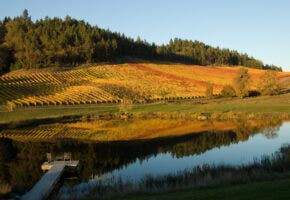What is Mourvèdre
Mourvèdre is a red variety known for the rich and meaty wines that it is a key component of, particularly those from the South of France, including the Rhône and Provence regions, and the Jumilla region of Spain. Wines are sometimes single-varietal, but Mourvèdre is also an elemental component of some fine blended wines, like Bandol, which is a blend of this grape, Grenache, Cinsault, Carignan and Syrah.
Mourvèdre’s small, thick-skinned berries are nearly black in the vineyard, ripening late and reaching high sugar levels under the right conditions. Wines can be, as a result, high in alcohol. Vines are hearty, with many leaves, offering good shade and, for experienced winemakers, the opportunity to define the grape’s outcome through mindful pruning.
This particular variety benefits tremendously from different types of vine training. Despite its late ripening, Mourvèdre has a short window for picking. Acidity declines rapidly after the grape has hit its peak ripeness, so it requires a watchful eye in the vineyard. Vines also require good irrigation and dry, warm weather, since the grape is susceptible to powdery mildew. Winemaking standards and practices leave a strong mark on the wines made from this grape.
Mourvèdre offers a meaty, char-like quality, making it a good complement to grilled meats and other substantial fare. It is a notoriously earth-driven grape, with secondary notes so strong they often overpower the fruit, which tends to be dark and red in character. Cherries, blueberries, blackberries, and currants abound, but so do stewed fruits, like prunes.
The wines made from Mourvèdre tend to show moderate to high tannic structure, and selections from good vintages are suitable for mid- to long-term aging.
Spain
Mourvèdre is believed to have originated in Spain, where it is widely known as Monastrell or Mataro. It is still among the most widely planted reds, although that is steadily changing. Spanish law requires that Mourvèdre is one of the primary varieties in the wines of Alicante, Almansa, Jumilla, Valencia and Yecla. Spanish Mourvèdre produces distinct, beefy and muscular wines, many of which see ample oak.
France
Mourvèdre was likely brought from Spain to France by the Phoenicians. The grape established itself as integral to Southern French winemaking as early as the 16th century.
Beginning in Roussillon, the grape quickly found homes in Provence and the Rhône Valley. The phylloxera crisis of the 19th century decimated a lot of Mourvèdre vines, which were found to be poor matches for grafting onto American rootstock. As a result, many vineyards that lost Mourvèdre vines to this epidemic were planted to other varieties.
Today, some of the most high-density plantings of Mourvèdre in France are in the Languedoc-Roussillon region in the country’s south.
Global Production
Mourvèdre has also crossed over into the New World, with plantings in California, Washington, Arizona, New Mexico, Texas, Virginia, and Missouri. These iterations tend to be a little less powerful and tannic than their Old World siblings. The grape has also found success in Australia, particularly in the Barossa Valley. Because it thrives in dry and warm climates, it is a natural fit for some New World winemaking regions.
Synonyms
Mourvèdre grapes are found in red, rose, sparkling, and dessert wines.










